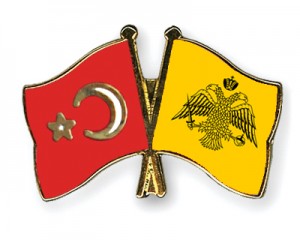When did Turkey become Turkish?
 Joost asks when exactly Turkey became Turkish. Or to put it another way, when did Byzantine (Greek) culture vanish from Asia Minor?
Joost asks when exactly Turkey became Turkish. Or to put it another way, when did Byzantine (Greek) culture vanish from Asia Minor?
It’s hard to emphasize just how deeply Hellenic roots run in Anatolia. Ionian settlers reached the western coast of Turkey as early as the 9th Century BC and made up a sort of Magna Graecia in Asia. Some of the most famous names in Greek history and mythology are associated with this area in what is now Turkey. Homer was supposedly born in Smyrna (Izmir), Herodotus was born in Halicarnassus (Bodrum), and Jason’s pursuit of the Golden Fleece took place on the Turkish coast of the Black Sea. These Ionian cities were instrumental in sparking the Persian Wars which ultimately resulted in Alexander the Great welding everything between the Balkans and India into a massive Hellenistic state. In 133 BC king Attalus of Pergamum (one of the last splinter kingdoms of Alexander’s empire) willed his territory to Rome and Anatolia entered the Roman Empire. It stayed in imperial hands from the 2nd century BC till the 11th AD without a serious break. In 1071, when the Byzantine army suffered a catastrophic defeat at Manzikert, parts of Asia Minor had been Greek for nearly two thousand years.
The most Hellenized regions were the coasts, and Byzantium recovered enough to retain control of them but the interior was officially abandoned. Once it was clear that the Crusades wouldn’t change the situation, the emperor Alexius Comnenus agreed to a treaty with the Seljuks allowing Christians to peacefully emigrate to imperial territory. This ensured the effective end of the Greek presence in the interior and its ultimate Turkification and Islamification.
The change, however, was relatively gradual- a slow eroding over the centuries. The Muslim authorities in Asia Minor referred to the Greek population as ‘the emperor’s church’ and as late as the fifteenth century were afraid that it would act as a fifth column in a Byzantine counterattack. Thriving Greek communities with their own schools, churches, and customs dating back to when Xenophon was marching ‘up country’ remained in place throughout the Ottoman Empire. What finally extinguished them was the great population exchange of 1923. Half a million Turks who had settled in Greece during Ottoman times were relocated to Turkey, and in exchange 1.5 million Greeks from Asia were transplanted in Greece. (Many of the homes they inhabited are still ghost towns today as the Turks refuse to live in them). We are in the very end stages of the complete disappearance of Greek traces from one of its ancient heartlands.
Istanbul was still a cosmopolitan city because it was exempted from the exchange, but in 1955 there were terrible racial pogroms that drove most of the Greeks away. In 1924 there were 200,000 Greeks living in the city and the last time a census was attempted (2006) there were barely 2,500. (Interestingly enough the opposite is true in Greece. The Turkish population of Thrace has had a growth rate of about 2.8% since 1951)
There is still one remnant holding on though. They are a group of ethnic Greeks living on the Black Sea coast near the Byzantine city of Trebizond. As Muslims they were exempted from the population exchange and they still speak an archaic form of Greek. It has the structure and grammar of medieval Greek- in other words it’s the one place on earth you can still hear the language of fourteenth century Byzantium. Ben Atlas provided a youtube clip: http://www.youtube.com/watch?v=UcAYP4irSyQ
[…] This post was mentioned on Twitter by Eva Pananoudakis, Lars Brownworth. Lars Brownworth said: When did Turkey become Turkish? http://bit.ly/ez3hZu […]
Thank you for this wonderful answer, Lars. I had not heard about the great population exchange of 1923 before and didn’t think things might not date back as long as I had thought after all.
Those abandoned Greek towns in Turkey must be an interesting site. Doing some online searches, it looks like Şirince and Kayakoy are two such examples:
http://www.florencestudios.com/writing/sirince.html
http://travelmag.co.uk/?p=1064
Joost,
Thanks for these links. The little villages are all over Turkey and are fascinating places to visit. Last summer I stumbled on one in Cappadocia and had an hour to explore it. A haunting experience.
Actually, the exchange of the population was a shortsighted political decision which, in combination with current Turkish laws, today has threatened the very existence of the Ecumenical Patriarchate, since the patriarch of Constantinople (I read recently somewhere) has to be a person born in Turkey.
That’s right- the Turkish government stipulates that in order for their recognition to be given the Patriarch must be a native-born citizen. Given the rapidly declining Greek population, the current Patriarch may be the last one.
[…] And this a far larger story that just the obvious Buzantium. Lars Brownworth explains – When did Turkey become Turkish? “It’s hard to emphasize just how deeply Hellenic roots run in Anatolia. Ionian settlers […]
Thanks for for the history lesson. This was a problem for scrip writers for Downton Abbey as they had a ‘Turkish’ diplomat in their series in 1913, ten years before there was a ‘Turkey’. The time of the population transfer must have been horribly difficult.